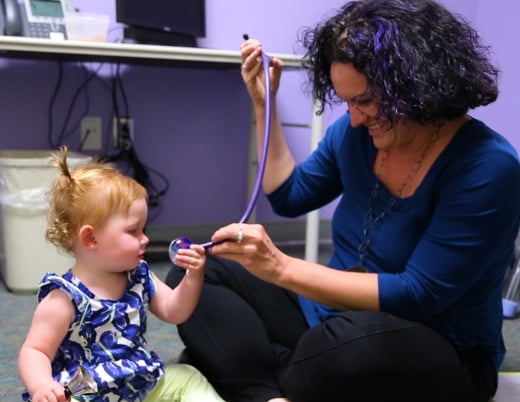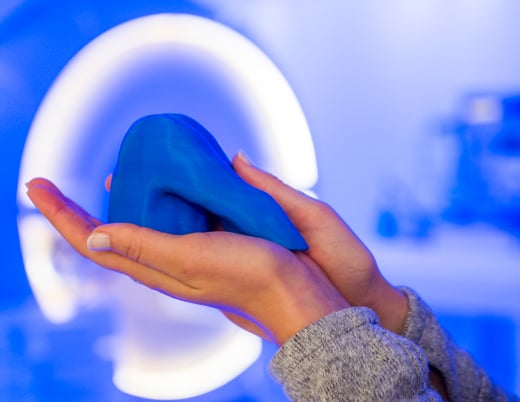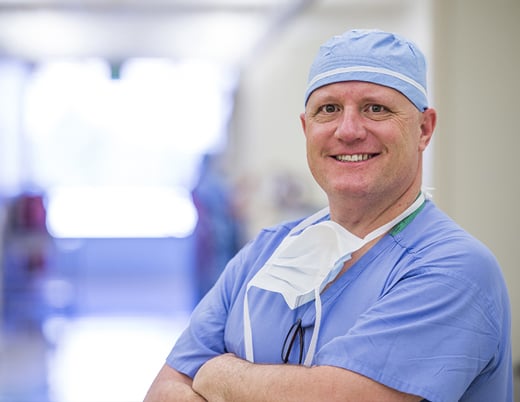What if medicine could not only diagnose a genetic mutation in utero, but intervene?
With ever more advanced genetic testing tools available, it’s possible to diagnose an array of genetic conditions, even very rare ones, before a child is born. “But we can’t do much about it,” says fetal surgeon and maternal fetal medicine specialist Michael Zaretsky, MD. “We know a genetic condition like cystic fibrosis will lead to pancreatic disease, intestinal complications, airway malformation. Our concept is to treat the disease before those manifestations occur.”
A good candidate for gene-based therapy
In the last decade, pediatric pulmonologist Scott Sagel, MD, has seen incredible strides in his area of expertise. The development of rescue therapy for CFTR, the protein individuals with cystic fibrosis lack the ability to produce, was a game-changer.
As a clinical investigator in Children’s Hospital Colorado’s Breathing Institute, the largest cystic fibrosis research center in the U.S., Dr. Sagel has been involved in clinical trials aimed at applying CFTR protein rescue therapies to a wider variety of mutations in increasingly younger children. That’s key because the damage caused by the disease process begins early and is often irreversible. The earlier it’s treated, the more damage it’s possible to prevent.
“We think a gene-based therapy will be the next major breakthrough,” he says.
And cystic fibrosis makes a good candidate for gene-based therapy. When Dr. Zaretsky first got interested in applying CRISPR gene editing to prenatally diagnosed genetic conditions three years ago, he developed a few criteria: It had to be a single-gene mutation with in-utero manifestations that shortens the lifespan, causes significant morbidity and, importantly, attracts funding. Cystic fibrosis was the clear winner.
But that didn’t make it an easy sell.
“Fetal therapy is already a foreign concept,” Dr. Zaretsky says. “Gene therapy takes it to a whole new level. It’s never been done. If you want data on this, there isn’t any. There’s nothing to go by."
“The first time I pitched it,” he adds, laughing. “It just drew a complete blank.”
Prenatal gene therapy in a large animal model
Molecular biologist Sean McGrath, PhD, an instructor at the University of Colorado School of Medicine who was at the time managing the Stem Cell Biobank and Disease Modeling Core at the Gates Center for Regenerative Medicine, was one of the first to join the team. Dr. Zaretsky reached out to Dr. McGrath after learning of his experience with CRISPR.
Three years later, despite humble beginnings, Dr. Zaretsky has succeeded in assembling basic scientists from Children’s Colorado, the University of Colorado School of Medicine, Colorado State University and National Jewish Health. It’s a team Dr. Zaretsky is excited and honored to work with.
Of course, his work set the project in motion and has been critical in the success it has had so far. Already the team has created a CRISPR construct that targets f508del, the most common mutation of the CFTR gene, shared by nearly 90% of individuals with cystic fibrosis. They’ve lab-tested it to make sure it modifies the genome where it’s supposed to. They’ve packaged the construct into an adeno-associated viral delivery system. And they’ve tested it in a large animal model at mid-gestation, delivering the therapy through the umbilical vein. They’re now awaiting results.
“The thing is,” Dr. McGrath says, “it’s actually pretty easy to make a system that will modify the CFTR locus. Those tools are well established. Moving away from the lab bench and editing within a living animal is far more complicated.”
Finding the best methods for delivering therapy
CFTR mutations only affect a handful of cell types, but the gene is present in every cell of the body. How gene editing will affect those other cells and systems remains to be answered. Is the treatment safe? Does it introduce unwanted artifacts? How do you deliver the treatment to the right cells, and can it fix enough of them to correct the phenotype? And will the fix last?
“Right now, they’re looking at a viral-based vector,” says Dr. Sagel. “We know that viruses infect respiratory cells. That’s what makes them attractive for lung disease. But the body also mounts an immune reaction, so you have to account for that. There are other ways to get things into cells. We just don’t know yet which vehicle is best.”
Still there’s encouraging evidence that the idea is fundamentally viable. In one proof-of-concept study, researchers delivered CRISPR gene-editing reagents to the amniotic fluid of a small animal model and were able to successfully modulate otherwise-fatal genetic interstitial lung disease.
“It was able to correct enough lung disease to have survivors,” says Dr. Zaretsky. “If you’re able to correct enough cells, you probably don’t need to get to 100%. You can still ameliorate the disease.”
And what works for cystic fibrosis could have implications for any single-gene mutation that affects the lungs or digestive system. But it’s a long road ahead.
“I think the ultimate goal is to cure,” says Dr. Sagel. “What Dr. Zaretsky and his group are doing will get us closer.”
“It’s a dream, and we have the potential tools to make it a reality,” Dr. Zaretsky says. “It’s going to take a long time, but it has to start somewhere.”
Featured Researchers

Michael Zaretsky, MD
Director of Research
Colorado Fetal Care Center
Children's Hospital Colorado
Professor
OB-GYN-Maternal Fetal Medicine
University of Colorado School of Medicine

Scott Sagel, MD, PhD
Pulmonologist
Children's Hospital Colorado
Professor
Pulmonary Medicine - Department of Pediatrics
University of Colorado





 720-777-0123
720-777-0123









